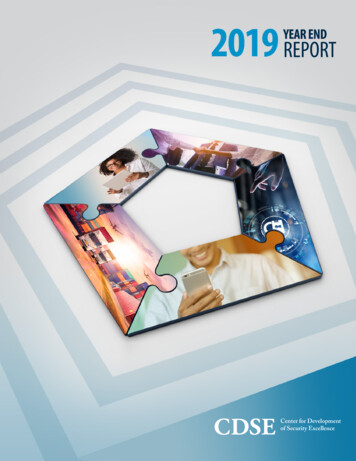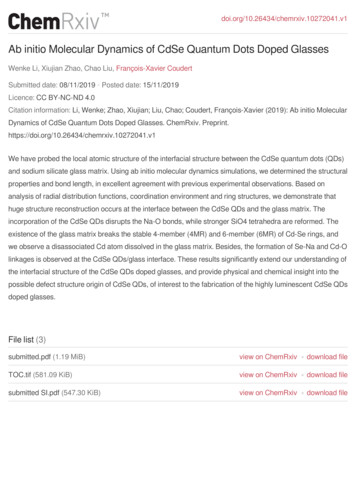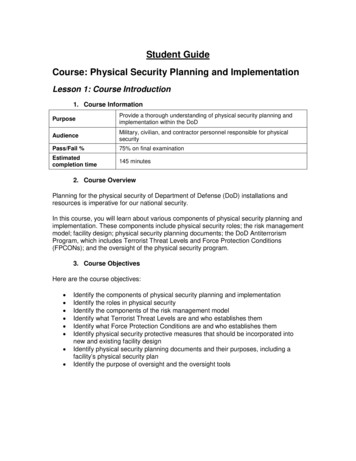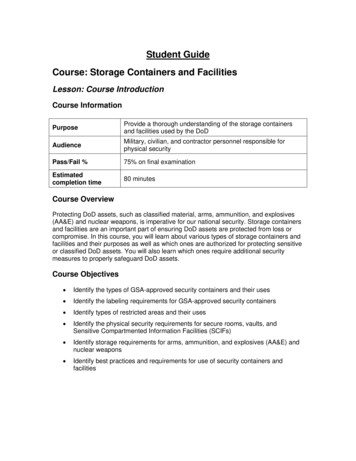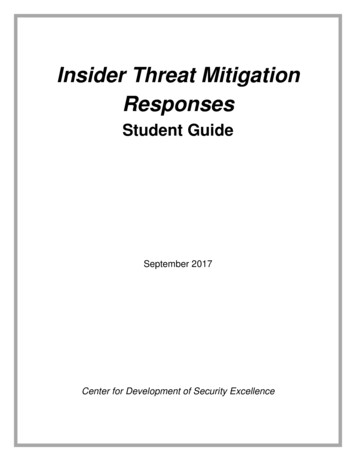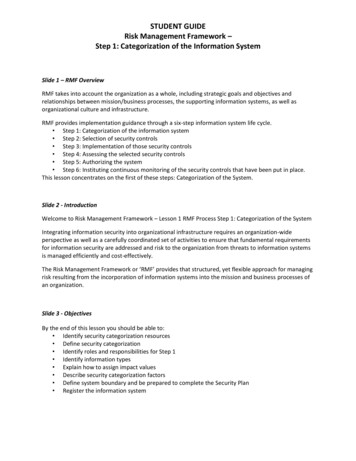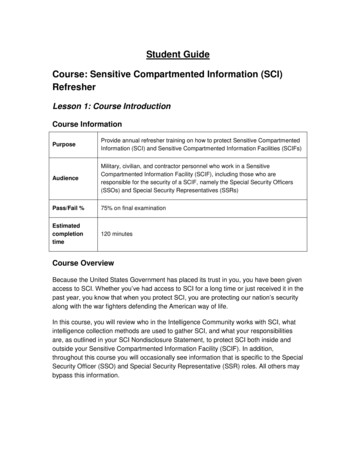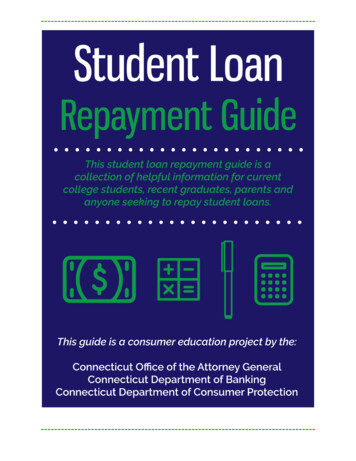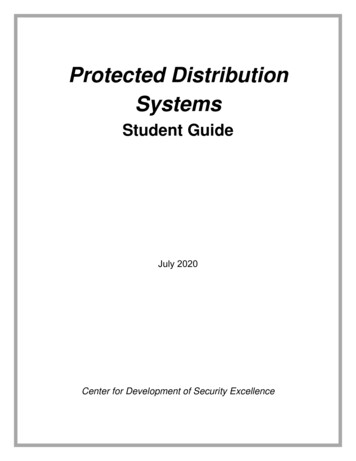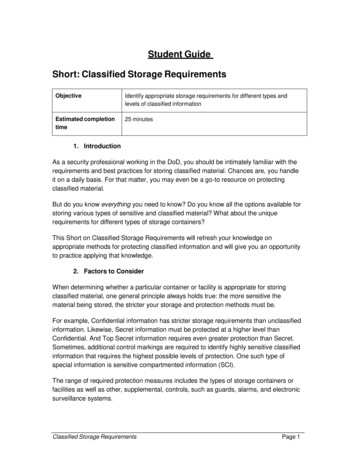
Transcription
Student GuideShort: Classified Storage RequirementsObjectiveIdentify appropriate storage requirements for different types andlevels of classified informationEstimated completiontime25 minutes1. IntroductionAs a security professional working in the DoD, you should be intimately familiar with therequirements and best practices for storing classified material. Chances are, you handleit on a daily basis. For that matter, you may even be a go-to resource on protectingclassified material.But do you know everything you need to know? Do you know all the options available forstoring various types of sensitive and classified material? What about the uniquerequirements for different types of storage containers?This Short on Classified Storage Requirements will refresh your knowledge onappropriate methods for protecting classified information and will give you an opportunityto practice applying that knowledge.2. Factors to ConsiderWhen determining whether a particular container or facility is appropriate for storingclassified material, one general principle always holds true: the more sensitive thematerial being stored, the stricter your storage and protection methods must be.For example, Confidential information has stricter storage requirements than unclassifiedinformation. Likewise, Secret information must be protected at a higher level thanConfidential. And Top Secret information requires even greater protection than Secret.Sometimes, additional control markings are required to identify highly sensitive classifiedinformation that requires the highest possible levels of protection. One such type ofspecial information is sensitive compartmented information (SCI).The range of required protection measures includes the types of storage containers orfacilities as well as other, supplemental, controls, such as guards, alarms, and electronicsurveillance systems.Classified Storage RequirementsPage 1
Student GuideThough the primary consideration in selecting a container or facility is the sensitivity ofthe information, there are several other factors that play into the real-world determinationof what storage methods are most appropriate. One factor is whether there are anyspecific threats that would require a higher level of protection (for example, storingclassified material in enemy territory). Another factor is the nature of the material beingstored. For example, storage requirements for weapons, large items, or heavy machinerywill be different than the requirements for printed or electronic media. Finally, thegeographic location of the materials being stored plays a role. The requirements thatapply to storing materials overseas—in a war zone, for example—may be different thanthose that apply to materials stored in the United States.Let's take a closer look at the specific storage requirements for each type of classifiedinformation.3. Storage by Classification LevelAll classified material must be stored in a secure room, a GSA-approved storagecontainer, such as a cabinet or safe or a vault or modular vault, or a sensitivecompartmented information facility (SCIF). Each of these containers and facilities will bedescribed in more detail later in this Short, but for now, we're going to start by looking athow they are used to store the types of classified material shown here.Remember: the more sensitive the information being stored, or the higher the level ofclassification, the more stringent the storage requirements must be. Therefore, theminimum storage requirements are different for each level of classified information.In some situations, a secure room or GSA-approved container is enough on its own toprotect classified material. However, in other situations, additional controls arenecessary to further safeguard the container or facility. These additional controls, knownas "supplemental controls," will be described in more detail later. For now, you simplyneed to know that they are required for storing some levels of classified material.a. ConfidentialConfidential material may be stored in a secure room, a cabinet or safe, or avault or modular vault. Confidential information may also be stored in a SCIF. Noadditional protection is required to store Confidential material in any of thesecontainers or facilities.b. SecretSecret material may also be stored in a secure room, a cabinet or safe, a vault ormodular vault, or a SCIF. However, if Secret material is stored in a secure room,Classified Storage RequirementsPage 2
Student Guidethen supplemental controls are required to ensure its protection. We'll look laterat the specific supplemental controls required for Secret material.c. Top SecretLike the lower levels of classified material, Top Secret material may also bestored in a secure room, a cabinet or safe, a vault or modular vault, or a SCIF.However, regardless of whether it is stored in a secure room, a cabinet or safe,or a vault, Top Secret material always requires supplemental controls. We'll looklater at the specific supplemental controls required for Top Secret material.d. Sensitive Compartmented Information (SCI)There is only one acceptable place to store SCI, and that is in a SCIF. Althoughany type of classified material may also be stored in a SCIF, SCI may NOT bestored in anything other than a SCIF.4. Containers and FacilitiesStorage containers and facilities are the physical spaces that are used to housevaluable, sensitive, and classified information and material to protect it againstunauthorized disclosure.Storage containers, such as secure rooms, GSA-approved security containers, andGSA-approved vaults, are generally designed to protect classified information andsmaller sensitive items such as small weapons.Storage facilities, on the other hand, are restricted areas designed to protect certaintypes of classified material or for the bulk storage of items that require larger spaces,such as missiles and other high-tech equipment. A SCIF, which is the most secure typeof storage discussed in this Short, is one type of storage facility.Whereas all classified storage facilities, such as SCIFs, are built to specific standardsthat authorize them to store specific types of information, the only storage containersthat are authorized to store classified information are secure rooms, which must meetspecific construction standards defined by the DoD, and GSA-approved securitycontainers and vaults, which must meet strict construction standards defined by theGeneral Services Administration (GSA).A GSA-approved container is any container that has been certified as meeting a certainminimum security standard for protection of classified information. The physicalconstruction standards vary by type of container, but the important thing for you to knowis that any container that is certified as a GSA-approved container is approved to storeclassified information.Classified Storage RequirementsPage 3
Student GuideGSAThe General Services Administration (GSA) establishes and publishes minimum standards,specifications, and supply schedules for containers, vault doors, modular vaults, and otherassociated security devices suitable for the storage and protection of classified informationagainst forced, covert, and surreptitious entry.a. Secure RoomsSecure rooms are areas designated and authorized for open storage of largevolumes of classified material.Secure rooms are used when larger storage capacity is needed than can beobtained from the use of GSA-approved security containers alone. Thesefacilities are built to enhanced commercial construction standards and do notafford the extra security that is inherent with vaults. However, it is important to beaware that some Components may have additional requirements prohibiting theopen storage of classified information in secure rooms.When a secure room is approved for the open storage of classified material, itmust be constructed in accordance with standards contained in DoD Manual5200.01, DoD Information Security Program. Such standards addressconstruction of floors, walls, ceilings and roofs, windows, and other openings.b. GSA-Approved Security ContainersGSA-approved security containers are used to store all levels of classifiedmaterial. They come in various configurations, such as security filing cabinets,map and plan containers, weapons storage containers, and informationprocessing system (IPS) containers.For use in mobile applications, such as aircraft, vehicular, or field environments,a portable field safe is an approved option as long as additional securitymeasures are in place to protect the container.Security Filing CabinetsGSA-approved security filing cabinets are available in one-, two-, four-, and five-drawerlegal and letter size configurations with either a single lock controlling all drawers orseparate locks on individual drawers.Security filing cabinets are manufactured in accordance with federal specification AAF-358J, as amended.Classified Storage RequirementsPage 4
Student GuideMap and Plan ContainersGSA-approved map and plan containers are used to store classified drawings, maps,plans, film, and other miscellaneous classified material. Various interior accessoriesare available for these containers.Security containers used for map and plan storage are manufactured in accordancewith federal specification AA-F-363D, as amended.Weapons Storage ContainersGSA-approved weapons storage containers are used to store small weapons andammunition. They are available in various configurations that can store a combinationof rifles and handguns, including divided weapons drawers that can hold up to 360weapons or a 32-capacity pullout rifle cart.Security containers used for weapons storage are manufactured in accordance withfederal specification AA-C-2859A.IPS ContainersGSA-approved IPS containers are constructed specifically for the protection ofclassified communications equipment. They come in several sizes and are designedfor closed-door, unmanned online operation of computers, network servers,workstations, and encryption devices that process classified information. IPScontainers feature rack-mounting assemblies, universal cable exit assemblies, powersupplies, and cooling systems.IPS containers are manufactured in accordance with federal specification AA-C-2786,as amended.Field SafesGSA-approved field safes are constructed specifically for use by military units workingin the field. Due to their relative light weight and portability, field safes must be securedto a permanent, immovable structure or remain under 24-hour observation by dutypersonnel or guards.Field safes are manufactured in accordance with federal specification AA-F-358J, asamended.Note that special caution must be taken not to simply chain the container through itslifting or carrying handle, as doing so provides little security and could damage thecontainer.The specific storage requirements for classified information within the DoD areoutlined in DoD Manual 5200.01.DoD Instruction 3224.03 describes requirements for acquiring physical securityequipment for use within the Department of Defense.Classified Storage RequirementsPage 5
Student Guidec. GSA-Approved Vaults and Modular VaultsLike secure rooms, GSA-approved vaults are areas designated and authorizedfor open storage of large volumes of classified material. Vaults are built to meetstrict forcible entry standards established by the GSA and outlined in DoDManual 5200.01. As such, they are more secure than secure rooms, featuringreinforced concrete walls, ceilings, and floors as well as hardened steel doors.A vault can be constructed in place, or it can be modular, meaning that it is prefabricated off-site and then assembled in place. Standards are slightly different forvaults and modular vaults, but when complete, both are considered equivalent forstorage purposes.d. Sensitive Compartmented Information Facilities (SCIFs)Sensitive compartmented information facilities (SCIFs), are used by members ofthe intelligence community for the storage of their sensitive compartmentedinformation (SCI).When building a SCIF, strict construction standards must be followed for floors,ceilings, walls, locks, windows, and other openings. The Director of NationalIntelligence (DNI) establishes security requirements for SCIFs. These standardsare defined in Intelligence Community Standard (ICS) 705-1, Physical andTechnical Security Standards for Sensitive Compartmented Information Facilities.Because a SCIF is a type of restricted area, it must be marked with"RESTRICTED AREA" warning signs posted at all perimeter boundaries andentrance zones of the SCIF. Note that in overseas areas, components mayrequire the host country's language to be included on these warning signs.5. Locks, Labels, and FormsYou've learned about the different types of storage containers that are authorized forstorage of classified material. All of these have certain baseline controls to ensure thatthey can adequately protect classified information. These controls include requirementsabout the correct locks to use, the labels that must be present and properly affixed to thecontainer, and the forms that certify how and when the containers are checked. Youneed to understand all of these requirements to ensure that you are properly storingclassified information.a. LocksA variety of different locks are approved to protect classified information. Allapproved locks must meet specific standards defined by the federal government.Classified Storage RequirementsPage 6
Student GuideExcept as provided elsewhere in the DoD Manual 5200.01, combination locks onvault doors, secure rooms, and security containers protecting classifiedinformation shall conform to Federal Specification FF-L-2740.The following locks have been authorized for use on GSA-approved securitycontainers and vaults. These are the Kaba Mas X-07, X-08, X-09, X-10, the S&G2740, 2740B, and the 2890PDL.The following locks have been authorized for use on secure rooms and SCIFs.They are the Kaba Mas CDX-07, CDX-08, and CDX-09, and CDX-10.Note that locks on vaults, secure rooms, and SCIFs must allow for theemergency egress of personnel inside.For bulk storage of large items that do not fit into a standard GSA-approvedstorage container, there are several approved padlocks. These are the S&G8077AD, 833C, and 951.The DoD Lock Program is an excellent resource for more detailed information.Federal Specifications Federal Specification FF-L-2740B, as amendedo Kaba Mas X-07, X-08, X-09, X-10o S&G 2740, 2740B, and 2890PDL Federal Specification FF-L-2890B, as amendedo Kaba Mas CDX-07, CDX-08, CDX-09, CDX-10 Federal Specification FF-P-110J, as amendedo S&G 8077AD Military Specification MIL-P-43607o S&G 833C, 951b. LabelsTo be authorized to store classified information, GSA-approved securitycontainers and vaults must clearly display the following labels: GSA-approved labelo Indicates that the container has been tested and certified by theGSAo On containers manufactured after October 1990, label is silverwith red letteringClassified Storage RequirementsPage 7
Student GuideooOn containers manufactured prior to October 1990, label is eithersilver with black lettering or black with silver letteringDisplayed on face of container Test certification labelo Identifies the class of container and the amount of time thecontainer protects against forced, covert, and surreptitious entryo Displayed on external side of control door Cabinet identification labelo Identifies the container model, serial number, date of manufacture,and government contract numbero Displayed on external side of control door or inside face of vaultdoor Number labelo Serves as container serial numbero Displayed on front face of container Warning labelo Warns against unapproved modification of the containero Displayed on top inside of control drawer or inside face of vaultdooro Displayed on containers manufactured in April 2007 or laterc. FormsRecords must be kept for all security containers, vaults, and secure rooms thatare used to store classified material. The following three forms are required forevery storage container: Standard Form (SF) 700: Security Container Informationo Contains vital information about security container, including itslocation, the container number, the lock serial number, highestlevel of classification, declassification instructions, and the contactinformation of individuals who should be contacted if container isfound open and unattendedo To order SF-700, call Federal Supply Service customer assistanceat 800-525-8027, Option 3, for stock number 7540-01-214-5372 Standard Form (SF) 701: Activity Security Checklisto Records end-of-day security checks, which are conducted toensure that work areas are secured at the end of each workingdayClassified Storage RequirementsPage 8
Student Guideo Allows for employee accountability in the event that irregularitiesare discoveredStandard Form 702: Security Container Check Sheeto Records the opening and closing of the storage containero Helps to narrow the scope of inquiryo Tracks types of useso Serves as reminder of required actionsNote that incomplete or inaccurate forms do NOT disqualify a container.However, any errors are noteworthy and should be reported to the securitymanager or appropriate security personnel.6. Supplemental ControlsIn addition to the baseline level of protection afforded by locks, labels, and forms,additional security measures, known as supplemental controls, are sometimes required.Supplemental controls include the following: Cleared guards or duty personnel providing continuous or periodic monitoring Intrusion detection systems (IDS), which are electronic systems designed todetect and transmit information about unauthorized access to a secured area Security-in-depth, which integrates various complementary layers of securityoSecurity-in-depth is a determination made by the Component Head orSenior Agency Official (for the DoD) or the Cognizant Security Agency(for cleared contractor facilities) that a security program consists oflayered and complementary security controls sufficient to deter and detectunauthorized entry and movement within a facility.As you learned earlier, unless it is stored in a SCIF, Top Secret material always requiressupplemental controls, and Secret material requires supplemental controls any time it isstored in a secure room. But what specific measures are required to protect these typesof materials in these types of storage environments?a. Top Secret Material Stored in Secure RoomsIf Top Secret information is stored in a secure room, then it must also beprotected by an IDS. In this case, the required security force response timesdiffer based on the presence or absence of security-in-depth. If the area is covered by security-in-depth, then the IDS response mustoccur within 15 minutesClassified Storage RequirementsPage 9
Student Guide If the area is not covered by security-in-depth, then the response mustoccur within five minutesb. Top Secret Material Stored in Security ContainersIf Top Secret information is stored in a GSA-approved security container, then itmust also be protected by one of the following supplemental controls: Continuous protection by a cleared guard or duty personnel Inspection of the container by a cleared guard or duty personnel everytwo hours IDS with a 15-minute response time Security-in-depth using a GSA-approved container equipped with anapproved lockc. Top Secret Material Stored in VaultsIf Top Secret information is stored in a GSA-approved vault, then it must also beprotected by an IDS. In this case, the required security force response timesdiffer based on the presence or absence of security-in-depth. If the area is covered by security-in-depth, then the IDS response mustoccur within 15 minutes If the area is not covered by security-in-depth, then the response mustoccur within five minutesd. Secret Material Stored in Secure RoomsIf Secret information is stored in a secure room then it must also be protected byone of the following supplemental controls: Continuous protection by a cleared guard or duty personnel Inspection of the container by a cleared guard or duty personnel everyfour hours IDS with a 30-minute response timeClassified Storage RequirementsPage 10
Student GuideJOB AID: STORAGE BY CLASSIFICATION LEVELType of Storage ContainerSecure RoomsVaultsSCIFsSCI may not be stored in a secureroom.SCI may not be stored in a securitycontainer.SCI may not be stored in a vault.SCI may be stored only in a SCIF.TOP SECRETTop Secret material may be stored in asecure room and requires one of thefollowing supplemental controls: IDS with 15-minute response timein areas covered by security-indepth IDS with 5-minute response timein areas not covered by securityin-depthTop Secret material may be stored in aGSA security container and requiresone of the following supplementalcontrols: Continuous protection by clearedguard or duty personnel Inspection by a cleared guard orduty personnel every two hours IDS with 15-minute response time Security-in-depth using GSAapproved container equipped withan approved lockTop Secret material may be stored inan approved vault and requires one ofthe following supplemental controls: IDS with 15-minute response timein areas covered by security-indepth IDS with 5-minute response timein areas not covered by securityin-depthTop Secret material may be stored in aSCIF.SECRETSecret material may be stored in asecure room and requires one of thefollowing supplemental controls: Continuous protection by clearedguard or duty personnel Inspection by a cleared guard orduty personnel every four hours IDS with 30-minute response timeSecret material may be stored in aGSA-approved security containerwithout supplemental controls.Secret material may be stored in anapproved vault without supplementalcontrols.Secret material may be stored in aSCIF.CONFIDENTIALConfidential material may be stored ina secure room and requires nosupplemental controls.Confidential material may be stored ina GSA-approved security containerwithout supplemental controls.Confidential material may be stored inan approved vault withoutsupplemental controls.Confidential material may be stored ina SCIF.SCIClassification LevelSecurity ContainersClassified Storage RequirementsPage 11
Student GuidePractical ExerciseLet's see how well you can identify where different levels of classified material can bestored. You will be presented with a series of scenarios in which you'll be asked to storesome classified documents. In each one, you will review some information about thestorage environment and its features and characteristics. You will then be asked todetermine which documents, if any, can be stored there. Be sure to select all possibleanswers for each activity.Activity 1: Security ContainerYou come away from a classified project meeting with several classified documents tostore. Read the following description of the storage environment; then decide whichclassified documents can be stored in this container. The security container is a four-drawer GSA-approved security filing cabinetlocated in an office area. The cabinet is secured with a commercial padlock hanging from a lock ring withhasp attached to the top drawer. A GSA-approved label is displayed on the face of the locked drawer. A number label is displayed on the cabinet frame centered above the drawer. An SF-702 is displayed on the side of cabinet; the form is up to date and containsall required information. A CLOSED magnet is displayed on the face of the cabinet. An IDS sensor is visible in the upper corner of room; the IDS response time isfive minutes.Which classified documents can be stored in this container? Confidential Top secret Secret SCIClassified Storage Requirements NonePage 12
Student GuideActivity 2: VaultYour supervisor has assigned you to store some classified documents. Read thefollowing description of the storage environment; then decide which classifieddocuments can be stored in this container. The storage container is a GSA-approved vault. The vault door is secured with a Kaba Mas X-09 lock. A GSA-approved label is displayed on the face of the vault door. A number label is displayed on the door frame centered above the vault door. An SF-701 is displayed on a clipboard hanging on the wall beside the vault door;the form is up to date and contains all required information. A guard is present in the vicinity of the vault door; the guard inspection interval isevery four hours. No IDS sensor is visible.Which classified documents can be stored in this container? Confidential Top Secret Secret SCIClassified Storage Requirements NonePage 13
Student GuideActivity 3: Security ContainerRead the following description of the storage environment; then decide which classifieddocuments can be stored in this container. The security container is a four-drawer GSA-approved security filing cabinetlocated in an office area. The cabinet is secured with a Kaba Mas X-09 lock. A GSA-approved label is displayed on the face of the locked drawer. A number label is displayed on the cabinet frame centered above the drawer. An SF-702 is displayed on the side of cabinet; the form is blank and contains noinformation. A CLOSED magnet is displayed on the face of the cabinet. An IDS sensor is visible in the upper corner of room; the IDS response time is 15minutes.Which classified documents can be stored in this container? Confidential Top Secret Secret SCIClassified Storage Requirements NonePage 14
Student GuideActivity 4: Secure RoomThis secure room is not regularly inspected by a guard nor is it monitored by an IDS.Read the following description of the storage environment; then decide which classifieddocuments can be stored in this container. The storage container is a secure room. The secure room door is secured with a Kaba Mas CDX-09 lock. No labels are displayed on the face of the secure room door. An SF-701 is displayed on a clipboard hanging on the wall beside the vault door;the form is up to date and contains all required information. No guard or IDS sensor is visible.Which classified documents can be stored in this container? Confidential Top Secret Secret SCIClassified Storage Requirements NonePage 15
Student GuideActivity 5: Secure RoomThis secure room is in an area protected by security-in-depth but is not regularlyinspected by a guard. Read the following description of the storage environment; thendecide which classified documents can be stored in this container. The storage container is a secure room. The secure room door is secured with a Kaba Mas CDX-09 lock. No labels are displayed on the face of the secure room door. An SF-701 is displayed on a clipboard hanging on the wall beside the vault door;the form is up to date and contains all required information. An IDS sensor is visible in the upper corner of room; the IDS response time is 15minutes.Which classified documents can be stored in this container? Confidential Top Secret Secret SCIClassified Storage Requirements NonePage 16
Student GuideAnswer KeyActivity 1: Security ContainerYou come away from a classified project meeting with several classified documents tostore. Read the following description of the storage environment; then decide whichclassified documents can be stored in this container. The security container is a four-drawer GSA-approved security filing cabinetlocated in an office area. The cabinet is secured with a commercial padlock hanging from a lock ring withhasp attached to the top drawer. A GSA-approved label is displayed on the face of the locked drawer. A number label is displayed on the cabinet frame centered above the drawer. An SF-702 is displayed on the side of cabinet; the form is up to date and containsall required information. A CLOSED magnet is displayed on the face of the cabinet. An IDS sensor is visible in the upper corner of room; the IDS response time isfive minutes.Which classified documents can be stored in this container? Confidential Top Secret Secret SCI NoneFeedback: You may not store any of these documents here. Because this containerdoes not have a GSA-approved lock, it is not a GSA-approved container and is notauthorized to store any type of classified material.Classified Storage RequirementsPage 17
Student GuideActivity 2: VaultYour supervisor has assigned you to store some classified documents. Read thefollowing description of the storage environment; then decide which classifieddocuments can be stored in this container. The storage container is a GSA-approved vault. The vault door is secured with a Kaba Mas X-09 lock. A GSA-approved label is displayed on the face of the vault door. A number label is displayed on the door frame centered above the vault door. An SF-701 is displayed on a clipboard hanging on the wall beside the vault door;the form is up to date and contains all required information. A guard is present in the vicinity of the vault door; the guard inspection interval isevery four hours. No IDS sensor is visible.Which classified documents can be stored in this container? Confidential Top Secret Secret SCI NoneFeedback: Both Confidential and Secret material may be stored here. However, becausethis vault is not protected by an IDS, Top Secret information may not be stored here.Note: SCI may not be stored here under any circumstances; it can only be stored in aSCIF.Classified Storage RequirementsPage 18
Student GuideActivity 3: Security ContainerRead the following description of the storage environment; then decide which classifieddocuments can be stored in this container. The security container is a four-drawer GSA-approved security filing cabinetlocated in an office area. The cabinet is secured with a Kaba Mas X-09 lock. A GSA-approved label is displayed on the face of the locked drawer. A number label is displayed on the cabinet frame centered above the dr
Storage containers and facilities are the physical spaces that are used to house valuable, sensitive, and classified information and material to protect it against . universal cable exit assemblies, power supplies, and cooling systems. IPS containers are manufactured in accordance with federal specification AA-C-2786, as amended.
